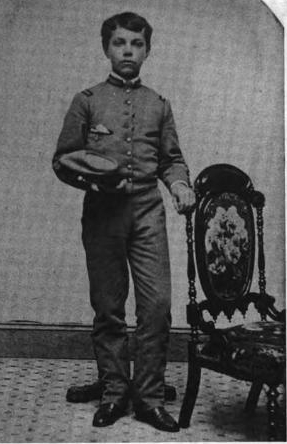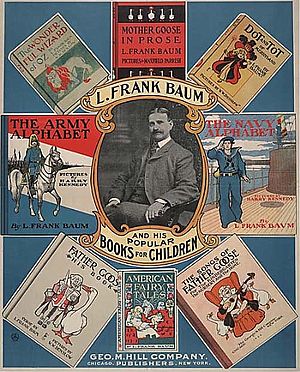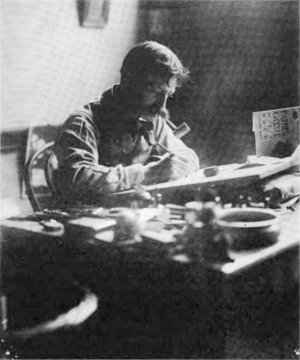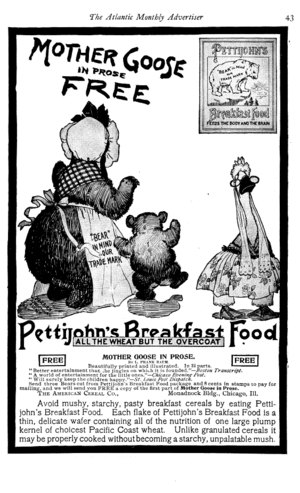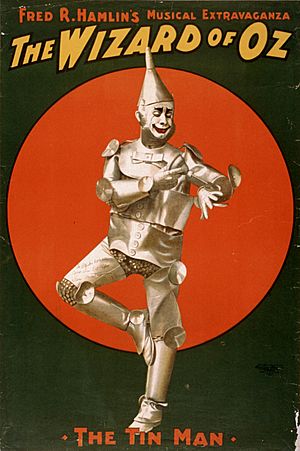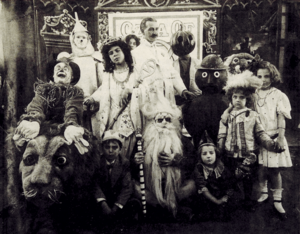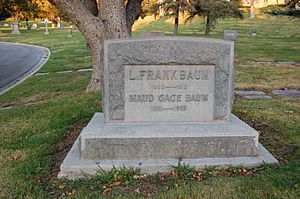L. Frank Baum facts for kids
Quick facts for kids
L. Frank Baum
|
|
|---|---|
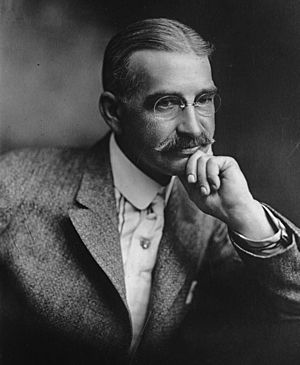
Baum, c. 1911
|
|
| Born | Lyman Frank Baum May 15, 1856 Chittenango, New York, U.S. |
| Died | May 6, 1919 (aged 62) Los Angeles, California, U.S. |
| Resting place | Forest Lawn Memorial Park |
| Pen name |
|
| Occupation | Author |
| Genre |
|
| Spouse |
Maud Gage
(m. 1882) |
| Children | 4, including Frank and Harry |
| Relatives | Matilda Joslyn Gage (mother-in-law) Roger S. Baum (great-grandson) |
| Signature | |
 |
|
Lyman Frank Baum (/bɔːm/; May 15, 1856 – May 6, 1919) was an American author. He is best known for his amazing children's books, especially The Wonderful Wizard of Oz and its many sequels. He wrote 14 novels in the Oz series. He also wrote 41 other novels, 83 short stories, over 200 poems, and at least 42 plays.
Baum tried many times to bring his stories to the stage and screen. The 1939 movie based on the first Oz book became a classic film.
Born in upstate New York, Baum moved west after trying to be a theater producer. He and his wife opened a store in South Dakota. He also worked as a newspaper editor there. Later, they moved to Chicago. He became a newspaper reporter and published children's books. The first Oz book came out in 1900. While still writing, he tried to start a film studio in Los Angeles. This studio would focus on movies for kids.
His stories even imagined things that are common today. These include television, augmented reality (like special glasses that add computer images to what you see), and laptop computers (in The Master Key). He also imagined wireless telephones (in Tik-Tok of Oz). He wrote about women in exciting jobs (in Mary Louise in the Country). He also predicted how much clothing is advertised today (in Aunt Jane's Nieces at Work).
Contents
Early Life and Childhood
Baum was born in Chittenango, New York, in 1856. His family was Methodist. He had German, Scots-Irish, and English family roots. He was the seventh of nine children. Only five of them lived to be adults. He disliked his first name, Lyman, and preferred his middle name, Frank.
His father was successful in many businesses. These included making barrels, drilling for oil in Pennsylvania, and buying and selling land. Baum grew up on his parents' large estate called Rose Lawn. He remembered it as a wonderful place. Rose Lawn was in Mattydale, New York. Frank was a sickly child who loved to dream. He was taught at home with his brothers and sisters. When he was 12, he spent two unhappy years at Peekskill Military Academy. After being punished for daydreaming, he became very ill. He was then allowed to return home.
Baum started writing when he was young. This might have been because his father bought him a small printing press. He was always close to his younger brother, Henry (Harry) Clay Baum. Harry helped him make The Rose Lawn Home Journal. The brothers published several issues of the journal. They included ads from local businesses. They gave it to family and friends for free. By age 17, Baum started another journal called The Stamp Collector. He also printed an 11-page booklet called Baum's Complete Stamp Dealers' Directory. He even started a stamp dealership with friends.
When he was 20, Baum became interested in breeding fancy chickens. He focused on raising Hamburg chickens. In 1880, he started a monthly magazine called The Poultry Record. In 1886, when he was 30, his first book was published. It was called The Book of the Hamburgs. It was about raising different kinds of Hamburg chickens.
Baum loved to be the center of fun at home. This was true even when his family had money problems. He made the Fourth of July special by selling fireworks. His skyrockets and fireworks lit up the sky. Many neighbors would gather to watch. Christmas was even more fun. Baum dressed as Santa Claus for his family. His father would hide the Christmas tree behind a curtain. This way, Baum could talk to everyone while decorating the tree without being seen. He kept this tradition his whole life.
Career and Works
Theater Adventures
Baum loved the theater throughout his life. He often had mixed financial success with it. A local theater group tricked him into buying them costumes. They promised him main roles, but it didn't work out. Disappointed, Baum left the theater for a while. He worked as a clerk in his brother-in-law's dry goods store in Syracuse.
But Baum couldn't stay away from the stage for long. He acted in plays using the names Louis F. Baum and George Brooks. In 1880, his father built him a theater in Richburg, New York. Baum started writing plays and putting together a group of actors. His play The Maid of Arran was a small success. It was a melodrama with songs, based on a novel. Baum wrote the play, composed songs for it, and played the main character. His aunt, Katharine Gray, who founded a speech school, played his character's aunt. Baum even advertised that he could teach theater skills.
On November 9, 1882, Baum married Maud Gage. Her mother was Matilda Joslyn Gage, a famous activist for women's suffrage (the right for women to vote). While Baum was touring with The Maid of Arran, his theater in Richburg caught fire. The fire destroyed the theater and many of Baum's play scripts and costumes.
Life in South Dakota
In July 1888, Baum and his wife moved to Aberdeen, Dakota Territory. He opened a store called "Baum's Bazaar." But he often let people buy things on credit, meaning they paid later. This caused his store to go out of business. So, Baum started editing the local newspaper, The Aberdeen Saturday Pioneer. He wrote a column called Our Landlady.
Baum's description of Kansas in The Wonderful Wizard of Oz was based on his time in South Dakota. The area suffered from droughts, making it very dry. During this time, Maud's mother, Matilda Joslyn Gage, lived with the Baums. While in South Dakota, Baum sang in a group that included James H. Kyle. Kyle later became an important Senator for the Populist Movement.
Becoming a Writer
Baum's newspaper failed in 1891. He, Maud, and their four sons moved to Chicago. Baum got a job reporting for the Evening Post. In 1897, he started a magazine called The Show Window. It focused on how stores displayed items in their windows. This magazine is still around today, called VMSD magazine. In 1900, Baum wrote a book about window displays. He said that mannequins were important for attracting customers. He also worked as a traveling salesman.
In 1897, he wrote Mother Goose in Prose. This book retold Mother Goose rhymes as stories. It was illustrated by Maxfield Parrish. Mother Goose was a moderate success. It allowed Baum to quit his sales job, which was bad for his health. In 1899, Baum worked with illustrator W. W. Denslow. They published Father Goose, His Book, a collection of silly poems. This book was a big hit. It became the best-selling children's book of the year.
The Wonderful Wizard of Oz
In 1900, Baum and Denslow published The Wonderful Wizard of Oz. They shared the copyright. The book received great reviews and made a lot of money. It was the best-selling children's book for two years. Baum went on to write thirteen more novels about the magical Land of Oz.
The Wizard of Oz on Stage
Two years after Wizard was published, Baum and Denslow worked with composer Paul Tietjens and director Julian Mitchell. They created a musical play based on the book. This stage version opened in Chicago in 1902. It was the first to use the shorter title "The Wizard of Oz." It then played on Broadway for 293 nights in 1903. It was so popular that it toured the United States until 1911.
The stage play was quite different from the book. It was mostly for adults. Toto the dog was replaced with Imogene the Cow. New characters like Tryxie Tryfle and Pastoria were added. The Wicked Witch of the West was completely removed. The story became about the four friends helping the Wizard, who was trying to take over Oz. It's not clear how much control Baum had over these changes. Many changes were made because of his contracts. The play also had jokes about famous people like President Theodore Roosevelt.
Because the stage version was so successful, many later versions of the story used the shorter title "The Wizard of Oz." This includes newer editions of the book. Today, people often use the full original title to tell the book apart from the Hollywood movie.
Baum wrote another Oz book, The Marvelous Land of Oz. He hoped to turn it into a play called The Woggle-Bug. But the actors who played the Scarecrow and Tin Woodman in the first play didn't want to be in it. So, the Scarecrow and Tin Woodman were left out of this new play. Critics thought it was a copy of his earlier work. It was a big failure and never made it to Broadway.
He also worked for years on a musical version of Ozma of Oz. This eventually became The Tik-Tok Man of Oz. It did fairly well in Los Angeles. But it wasn't successful enough to be brought to New York. He also started a play version of The Patchwork Girl of Oz. This was later made into a movie.
Later Life and Other Works
After Wizard became a hit, Baum and Denslow published Dot and Tot of Merryland in 1901. This book was not as good as their others. Its failure made their friendship difficult. It was their last project together. Baum then worked mostly with John R. Neill on his fantasy books starting in 1904.
Baum said several times that he had written his last Oz book. He wanted to write other fantasy stories about different magical lands. These included The Life and Adventures of Santa Claus and Queen Zixi of Ix. But he always returned to the Oz series. This was because people loved them, children sent him letters, and his new books didn't do as well. Even so, his other books remained popular after he died. The Master Key was still a favorite among readers in the 1920s.
In 1905, Baum announced plans for an Oz amusement park. He talked about buying an island off the coast of California. He wanted to turn it into an Oz park. He called it "Pedloe Island" and said it would be "a fairy paradise for children." He planned for statues of Oz characters. But there is no proof he ever bought such an island. Baum stopped his Oz park project after his play The Woggle-Bug failed in 1905.
Because he loved theater so much, he often paid for big musicals. This sometimes caused him money problems. One of his biggest financial struggles was with The Fairylogue and Radio-Plays (1908). This show combined slides, film, and live actors. Baum would give a lecture as if he were on a trip to Oz. But Baum couldn't pay his debts to the company that made the films. It took him several years to get back on his feet. He had to sell the rights to many of his earlier works, including The Wonderful Wizard of Oz.
Baum used several different names (pseudonyms) for some of his non-Oz books. These include:
- Edith Van Dyne (for the Aunt Jane's Nieces series)
- Laura Bancroft (for The Twinkle Tales, Policeman Bluejay)
- Floyd Akers (for The Boy Fortune Hunters series)
- Suzanne Metcalf (for Annabel)
- Schuyler Staunton (for The Fate of a Crown, Daughters of Destiny)
- John Estes Cooke (for Tamawaca Folks)
- Capt. Hugh Fitzgerald (for the Sam Steele series)
Baum also secretly wrote The Last Egyptian: A Romance of the Nile. He continued working in theater with a men's social group called The Uplifters. He wrote several plays for their events. The group included famous people like Will Rogers. They were proud to have Baum as a member.
In 1914, Baum started his own film company, The Oz Film Manufacturing Company. He was its president and main producer and writer. The company made films like The Patchwork Girl of Oz. But they didn't have much success with children's films. The "Oz" name became unpopular for movies at that time. Even changing the company name didn't help. Baum didn't invest his own money in this company, unlike his earlier show. But the stress likely affected his health.
Death
On May 5, 1919, Baum had a stroke. He went into a coma and died the next day, at age 62. His last words were to his wife during a brief moment of being awake: "Now we can cross the Shifting Sands." He was buried in Glendale's Forest Lawn Memorial Park Cemetery.
His last Oz book, Glinda of Oz, was published in 1920, a year after he died. Other authors continued the Oz series long after his death. Ruth Plumly Thompson wrote twenty-one more Oz books.
Baum's Beliefs
Literary Goals
Baum wanted his Oz books and other fairy tales to be different. He aimed to retell classic tales, like those by the Brothers Grimm and Hans Christian Andersen. But he wanted to make them more American and modern. He also wanted to remove common characters like dwarfs or genies. He also wanted to take out the violence and strong moral lessons often found in older fairy tales. His first Oz books had some violence. But it decreased as the series went on. In The Emerald City of Oz, Ozma even says she doesn't like violence.
Another thing Baum left out was a focus on romantic love. He thought young children weren't interested in it and wouldn't understand it. In The Wonderful Wizard of Oz, the only romance is in the past story of the Tin Woodman. It explains why he became tin, but it doesn't affect the main adventure.
Views on Society
Supporting Women's Rights
When Baum lived in Aberdeen, South Dakota, he was the secretary of its Equal Suffrage Club. This group worked to get women the right to vote. Susan B. Anthony, a famous women's rights leader, even visited Aberdeen and stayed with the Baums.
Some people believe that Baum's mother-in-law, Matilda Joslyn Gage, influenced his Oz books. Gage was a strong feminist activist. In The Marvelous Land of Oz, General Jinjur leads the girls and women of Oz in a revolt. They succeed and make the men do the housework. Jinjur isn't a good ruler, but Princess Ozma, who believes in gender equality, eventually takes the throne. Baum's stories outside of Oz also show themes of equality. His Edith Van Dyne stories feature girls and young women doing things usually done by men.
Racial Views and Apology
During the late 1800s, Baum wrote two newspaper articles. In these articles, he strongly suggested that Native Americans should be completely removed. He believed this was necessary for the safety of white settlers. These opinions are now seen as very wrong and harmful.
In 2006, two of Baum's descendants apologized to the Sioux nation. They expressed sorrow for any pain their ancestor's words had caused.
Baum's mother-in-law, Matilda Joslyn Gage, had different views. She was a strong supporter of Native American people. She was even welcomed into the Wolf Clan of the Iroquois Council of Matrons. This shows her respect for Native American culture.
Political Ideas in The Wizard of Oz
Many people have tried to find hidden political meanings in The Wonderful Wizard of Oz. In 1964, a history teacher named Henry Littlefield wrote an article. He suggested the novel was a metaphor for the politics of the 1890s. He focused on the Populist movement and debates about silver and gold money.
Baum was a Republican and supported women's right to vote. It is thought that he did not support the political ideas of the Populist movement. Baum's newspaper did discuss politics in the 1890s. Also, Denslow, the illustrator, was a political cartoonist. The 1902 stage version of The Wizard of Oz included some political jokes. But scholars have found few political references in Baum's Oz books after 1902. When asked if his stories had hidden meanings, Baum always said they were written only to "please children."
Religious Views
Baum was originally a Methodist. But he joined the Episcopal Church in Aberdeen. He did this to take part in community plays. Later, he and his wife became members of the Theosophical Society in 1892. This was encouraged by Matilda Joslyn Gage.
Baum's beliefs often appear in his writings. However, the only mention of a church in his Oz books is a porcelain one. The Cowardly Lion breaks it in the Dainty China Country in The Wonderful Wizard of Oz. The Baums sent their older sons to a "Ethical Culture Sunday School" in Chicago. This school taught good behavior, not religion.
Some writers suggest that Baum used hidden meanings in The Wonderful Wizard of Oz. They believe he wanted to share ideas from spiritual teachings like Theosophy. They think the characters' journey in Oz represents a soul's path to understanding. Baum himself suggested his story might have been inspired by a higher power. He said, "It was pure inspiration. It came to me right out of the blue. I think that sometimes the Great Author had a message to get across and He was to use the instrument at hand."
Works
- Mother Goose in Prose (1897)
- By the Candelabra's Glare (1898)
- Father Goose: His Book (1899)
- A New Wonderland (1900), later called The Magical Monarch of Mo (1903)
- The Army Alphabet (1900)
- The Navy Alphabet (1900)
- American Fairy Tales (1901)
- The Life and Adventures of Santa Claus (1902)
- The Enchanted Island of Yew (1903)
- John Dough and the Cherub (1906)
- Boy Fortune Hunters book series (1908-1911)
- The Sea Fairies (1911)
- Sky Island (1912)
- Queen Zixi of Ix (1905)
- The Fate of a Crown (1905)
- Sam Steele's Adventures on Land and Sea (1906)
- Daughters of Destiny (novel) (1906)
- The Last Egyptian (1907)
Land of Oz Works
- The Wonderful Wizard of Oz (1900)
- The Marvelous Land of Oz (1904)
- Queer Visitors from the Marvelous Land of Oz (1905, a comic strip)
- The Woggle-Bug Book (1905)
- Ozma of Oz (1907)
- Dorothy and the Wizard in Oz (1908)
- The Road to Oz (1909)
- The Emerald City of Oz (1910)
- The Patchwork Girl of Oz (1913)
- Little Wizard Stories of Oz (1913, a collection of 6 short stories)
- Tik-Tok of Oz (1914)
- The Scarecrow of Oz (1915)
- Rinkitink in Oz (1916)
- The Lost Princess of Oz (1917)
- The Tin Woodman of Oz (1918)
- The Magic of Oz (1919, published after he died)
- Glinda of Oz (1920, published after he died)
The book The Royal Book of Oz (1921) was said to be by Baum. But it was actually written entirely by Ruth Plumly Thompson.
Popular Culture and Legacy
- A 1970 TV show episode called "The Wizard of Aberdeen" showed Baum's time in South Dakota. It focused on him telling stories to children about a faraway land he called "Ooz."
- John Ritter played Baum in the TV movie The Dreamer of Oz: The L. Frank Baum Story (1990).
- Zach Braff plays a character named Frank Baum in Oz the Great and Powerful (2013). This character is named in honor of the author, but he is not meant to be the real L. Frank Baum.
- The theme park Storybook Land in Aberdeen, South Dakota, has an area dedicated to the Land of Oz. It features characters and attractions from the books.
- In 2013, Baum was added to the Chicago Literary Hall of Fame.
- The Woodsman, a 2012 play, tells the story of how the Tin Man became who he is. It uses puppets, movement, and music.
- Rusting Tin Man is a song from The Woodsman (Original Off-Broadway Solo Recording) by Edward W. Hardy. It is about Nick Chopper becoming the Tin Man.
See also
 In Spanish: L. Frank Baum para niños
In Spanish: L. Frank Baum para niños


